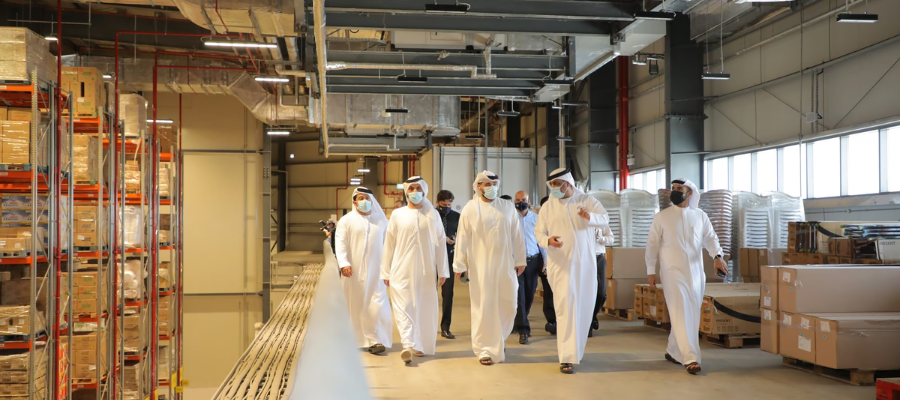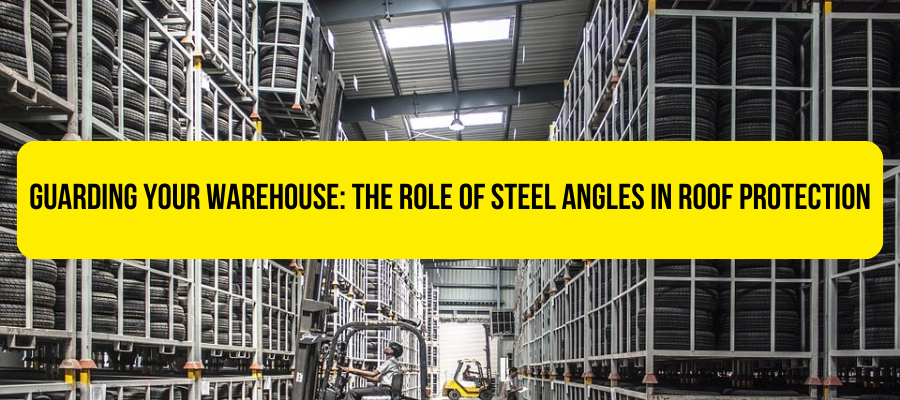Guarding Your Warehouse: The Role of Steel Angles in Roof Protection

The Role of Pipe Fittings in Water Safety
March 6, 2024Did you know that the global market for warehousing and storage is set to skyrocket to a whopping $585 billion by 2026? That’s a mind-blowing number, highlighting the increasing need for storage solutions worldwide. But here’s the thing: amidst all the hustle and bustle of warehouses, there’s something crucial we often overlook—the strength of their roofs.
Picture this: warehouses bustling with goods, buzzing with activity. But what keeps them standing strong against nature’s fury and industrial demands? Enter steel angles—small yet mighty components that act as silent guardians, fortifying warehouse roofs.
In our blog, we’re diving deep into the fascinating world of warehouse construction. We’ll uncover the hidden role of steel angles, those unsung heroes ensuring the safety and longevity of these essential structures. Get ready for a journey filled with jaw-dropping statistics, insightful details about steel angles, and a newfound appreciation for the fortification of warehouses. Join us as we unlock the secrets of warehouse construction and discover the power of steel in shaping the industrial landscape.
Problems Arising from Incorrect Angle Usage
Improper utilization of steel angles and channels in warehouse construction within the Middle East can pose significant challenges unique to the region’s industrial landscape. Structural weaknesses may arise if angles with inadequate thickness or mismatched dimensions are selected, potentially compromising the robustness of warehouses needed to withstand regional climatic conditions. The Middle East experiences extreme temperatures and occasional sandstorms, making it essential to choose angles that can withstand such environmental stresses.
Inadequate roof support is another concern, especially given the region’s occasional heavy rainfall and rare instances of snowfall in higher elevations. Utilizing angles with insufficient load-bearing capacity could result in roof collapse or damage, jeopardizing the safety of goods and personnel within the warehouse. Moreover, improper alignment during installation may exacerbate the risk, as misaligned angles could lead to uneven weight distribution and structural instability.
In a region prone to high humidity levels, corrosion vulnerability becomes even more critical. Neglecting proper corrosion protection measures could accelerate structural deterioration, necessitating costly repairs or replacements. Lastly, with space being a premium in the Middle East, inefficient space utilization due to improper angle selection could significantly impact storage capacity and material handling efficiency.
To address these challenges effectively, it’s imperative for warehouse operators in the Middle East to prioritize the selection, installation, and maintenance of steel angles with a keen understanding of regional environmental factors and industry-specific requirements. By doing so, they can enhance the resilience and functionality of warehouses, ensuring the safe storage and efficient management of goods in this dynamic region.
The Role of Steel Angles in UAE’s Warehouse Roof Protection
In the bustling industrial landscape of the Middle East, where warehouses stand as critical hubs for the storage and distribution of goods, ensuring the structural integrity and safety of these facilities is paramount. Amidst the region’s unique environmental challenges, standard steel angles emerge as silent guardians, playing a pivotal role in fortifying warehouse roofs against the relentless forces of nature and industrial demands.
Steel angles, with their L-shaped cross-section and sturdy composition, serve as the backbone of warehouse roof protection. Their versatility and resilience make them indispensable components in safeguarding warehouses against the region’s harsh climatic conditions, including extreme temperatures, sandstorms, and occasional heavy rainfall.
Warehouses, the epicenters of storage and distribution, demand sturdy and reliable structures to withstand the rigors of industrial operations. Steel angles and channels form the backbone of warehouse construction, providing foundational support, completing mezzanine systems, and reinforcing roofing structures. Whether supporting elevated flooring or forming part of the ceiling framework, steel angles ensure the structural integrity of warehouses, enabling them to withstand heavy loads and variable wind pressures.
One of the primary functions of steel angles in warehouse roof protection is to provide structural reinforcement. By selecting angles with adequate thickness and dimensions, warehouse operators can ensure the robustness of their roofs, enabling them to withstand the rigors of the Middle Eastern climate. Additionally, standard steel angles offer crucial support for roofing materials, preventing sagging, leaks, or even collapse under the weight of accumulated snow or rainfall.
Furthermore, steel angles play a vital role in ensuring proper alignment and installation of roofing components. Precise alignment is essential to distribute loads evenly and minimize stress concentrations, thereby enhancing the overall stability and longevity of the warehouse structure. With the region’s occasional heavy rainfall and rare instances of snowfall in higher elevations, proper alignment becomes even more critical to prevent roof damage and structural failure.
Corrosion protection is another crucial aspect of steel angles in warehouse roof protection, particularly in a region characterized by high humidity levels. Employing angles with adequate corrosion resistance helps mitigate the risk of premature deterioration, ensuring the long-term durability and reliability of warehouse roofs.
Moreover, steel angles contribute to efficient space utilization within warehouses, optimizing storage capacity and material handling efficiency. By carefully selecting angles that complement the warehouse layout and support systems, operators can maximize available space while ensuring seamless operations.
The Benefits of Understanding Steel Angles in Warehouse Construction
In the Middle Eastern industrial landscape, where warehouses play a crucial role in logistics, gaining a deep understanding of steel angles offers significant advantages. Knowing the nuances of these components enables operators to enhance structural stability, optimize space utilization, and prioritize safety.
Understanding steel angles allows for precise selection based on load-bearing requirements and corrosion resistance, ensuring warehouses can withstand the region’s environmental challenges. Additionally, proper knowledge facilitates accurate alignment during installation, reducing the risk of structural issues and costly repairs down the line.
Moreover, optimizing space within warehouses becomes easier with a thorough grasp of steel angles, leading to improved storage capacity and operational efficiency. This knowledge also fosters a safety-focused culture, mitigating risks and ensuring the well-being of personnel and assets.
The manufacturing sector relies on heavy machinery and equipment to drive productivity and efficiency. Steel angles find their way into the manufacturing process, offering reinforcement and protection to essential equipment. From forklifts and bulldozers to household appliances like washing machines and stoves, steel angles provide structural support and protection, reducing maintenance costs and enhancing longevity.
Their L-shaped cross-section, combined with high-strength properties, makes them ideal for framing structures, supporting handrails, and forming utility carts. Whether used in interior moldings or exterior cladding, steel angles add both aesthetic appeal and structural resilience to various architectural designs.
In essence, gaining expertise in steel angles empowers professionals to make informed decisions that enhance structural integrity, efficiency, and safety in warehouse construction and operations throughout the Middle East.
Types Of Steel Angles in Middle East: Unequal Steel Angles, Hot Rolled Steel Angles, Carbon Steel Angles
Steel angles come in various types, each with its unique characteristics and applications. Understanding these types is essential for selecting the most suitable angles for specific projects. Here, we delve into three prominent types: Unequal Steel Angles, Hot Rolled Steel Angles, and Carbon Steel Angles.
1. Unequal Steel Angles:
Unequal steel angles, as the name suggests, have unequal leg lengths, making them versatile for a range of applications. These angles offer distinct advantages in structural reinforcement, framework construction, and support systems. In the Middle East, where warehouse construction is booming, unequal steel angles play a pivotal role in providing stability and resilience to roofing structures. According to industry data, unequal steel angles are in high demand, with the global steel market projected to reach $1.01 trillion by 2025.
2. Hot Rolled Steel Angles:
Hot rolled steel angles are manufactured through a process of hot rolling, which involves passing steel through rollers at high temperatures to achieve the desired shape. This method results in angles with excellent structural properties, making them ideal for load-bearing applications. In the Middle East, where infrastructure development is accelerating, hot rolled steel angles find extensive use in bridge construction, building frames, and industrial machinery. With a projected CAGR of 6.2% from 2020 to 2027, the hot rolled steel market is witnessing robust growth globally.
3. Carbon Steel Angles:
Carbon steel angles, characterized by their high carbon content, offer exceptional strength and durability, making them suitable for demanding environments. These angles are widely used in manufacturing processes, equipment fabrication, and structural components. In the Middle East, where heavy industries thrive, carbon steel angles play a vital role in supporting machinery and infrastructure. Market research indicates that the global carbon steel market is expected to exceed $1.1 trillion by 2026, driven by increasing industrialization and construction activities.
In summary, Unequal Steel Angles, Hot Rolled Steel Angles, and Carbon Steel Angles are integral components in construction and industrial projects, each offering unique advantages and applications. By understanding the characteristics and uses of these steel angles, professionals can make informed decisions to ensure the success and durability of their projects.

In Conclusion, Guarding Your Warehouse in Middle East With Steel Angles
In conclusion, the diverse array of steel angles, encompassing unequal, hot rolled, and carbon steel variations, underscores their indispensable role in modern construction and industrial landscapes. From providing stability and resilience to roofing structures in warehouse construction to supporting heavy machinery and infrastructure in the Middle East’s thriving industrial sectors, these angles serve as foundational elements driving progress and innovation.
As the global steel market continues to expand, with projections soaring into the trillion-dollar range, the significance of understanding and leveraging the unique properties of each steel angle type cannot be overstated. By embracing this knowledge and incorporating it into design and construction practices, stakeholders in the Middle East can unlock enhanced structural integrity, efficiency, and safety across a myriad of projects, ultimately shaping a more robust and sustainable built environment for generations to come.
FAQ
Types Of Steel Angles?
Equal and unequal are the two major types of steel angle other types of steel angles include unequal, hot rolled, and carbon steel angles.
What Are Steel Angles Used For?
Steel angles are commonly used for structural reinforcement, framework construction, and support systems in various industries.
What Size Are Standard Steel Angles?
Standard steel angles typically come in various sizes ranging from small dimensions to larger profiles, depending on the application and load-bearing requirements. Standard steel angles come in various sizes, typically ranging from 20 mm to 200 mm in leg lengths and 3 mm to 20 mm in thickness, catering to diverse structural needs and applications. These dimensions may vary based on regional standards and industry requirements.
What Is The Size Of L Angle?
The size of an L angle or L-shaped steel can vary, with dimensions specified based on the length of each leg and the thickness of the angle. The size of an L angle, or L-shaped steel angle, varies widely, ranging from small profiles like 1″ x 1″ x 1/8″ to larger profiles such as 6″ x 6″ x 3/8″, depending on project specifications and load-bearing requirements. Custom sizes can also be fabricated to meet specific structural needs in construction and industrial applications.
What size is L shape steel?
The size of L-shape steel angles can range from small to large profiles, with dimensions tailored to meet specific structural needs and applications. L-shape steel, commonly known as angle iron, comes in various sizes, typically ranging from 2 inches by 2 inches to 4 inches by 4 inches, with thicknesses varying from 1/8 inch to 1/2 inch or more, catering to diverse structural requirements in construction and manufacturing.



